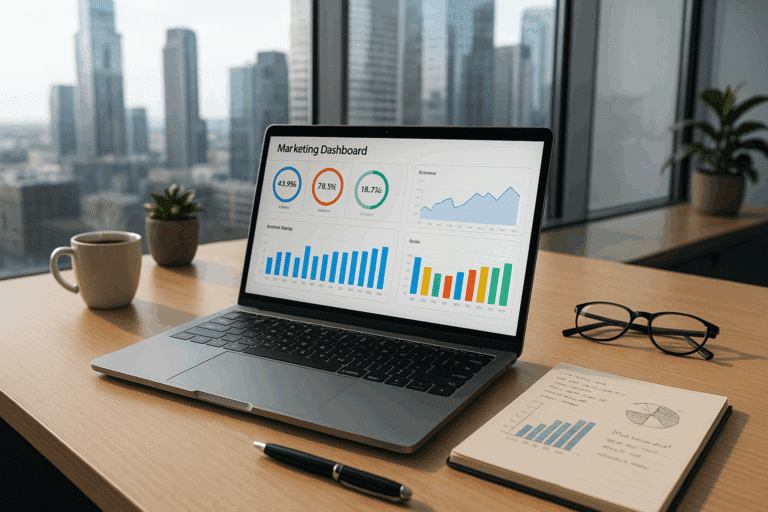The ability to harness and interpret this wealth of information can give your online business the edge it needs in today’s competitive marketplace. But how do you make sense of all this data, and how can you use it to drive your e-commerce success? The answer lies in custom dashboards and the power of data visualization and analytics. In this comprehensive guide, we delve into the world of custom dashboards, data visualization, and analytics, empowering you to optimize your e-commerce strategies and maximize success.
Picture this: a dashboard that gives you an immediate, easy-to-understand snapshot of your business performance at any given moment. 🔍 Imagine being able to see your sales trends, customer behavior, and inventory status all in one place. Sounds like a dream, doesn’t it? With custom dashboards, this becomes a reality, providing a powerful tool that enables you to make informed decisions quickly and efficiently.
As we navigate through the intricacies of e-commerce data, we’ll explore why custom dashboards are critical for your online business. We’ll delve into how they can boost your productivity, enhance your decision-making processes, and ultimately drive business growth. 🚀
But we don’t stop there. We also demystify the concept of data visualization and why it’s a game-changer in the world of e-commerce. No longer do you have to sift through endless spreadsheets or complex reports. Data visualization presents your business data in a graphical, intuitive format, making it easier than ever to identify patterns, trends, and insights that can propel your business forward.
And what about analytics? The term may seem daunting, but it doesn’t have to be. In fact, analytics can be your secret weapon in understanding your customers better, identifying opportunities for growth, and keeping a pulse on your business performance. 👀
Together, custom dashboards, data visualization, and analytics form a powerful trio that can supercharge your e-commerce success. Whether you’re a small online business owner or an e-commerce giant, these tools provide invaluable insights that can guide your business strategies, improve customer satisfaction, and boost your bottom line.
Ready to dive in? Buckle up and get ready to unlock the potential of your e-commerce business. We’ll guide you through the essential steps to create your custom dashboard, shed light on the benefits of data visualization, and reveal how to leverage analytics to make data-driven decisions that can catapult your business to new heights. Let’s embark on this exciting journey together. Are you ready to unleash the power of data in your e-commerce business? 💪
Maximize Your E-commerce Success: Embrace the Power of Custom Dashboards
As a seasoned technical writer with a focus on software engineering, I’ve witnessed the dramatic transformation brought about by data visualization and analytics in the E-commerce landscape. The e-commerce industry is flooded with data. Every click, purchase, cart abandonment, and customer review represents a valuable piece of information. However, deciphering this data to extract valuable insights can be daunting. Here’s where the real power of custom dashboards comes into play.
Custom dashboards, with their ability to provide real-time data analysis and visualization, can be a game-changer for your E-commerce business. They empower businesses to understand their performance, recognize trends, and make data-driven decisions. But what exactly are custom dashboards, and how can they optimize your E-commerce operations? Let’s delve deeper into the subject.
What are Custom Dashboards and Why are they Crucial?
Custom dashboards are personalized data interfaces that present your data in an easy-to-understand, visual format. They help you to keep track of the various metrics that matter most to your business. For instance, you can monitor sales data, customer behavior, marketing campaign performance, and much more, all in real-time.
One significant advantage of custom dashboards is their flexibility. You can customize them according to your specific needs, focusing on the metrics that matter most to your business. This way, you are not overwhelmed with unnecessary information, but rather, you are presented with the most relevant, actionable insights.
To give you a better understanding, let’s compare the custom dashboards with generic dashboards in the table below:
| Dashboard Type | Flexibility | Data Relevance | Actionable Insights |
| Custom Dashboards | High | High | High |
| Generic Dashboards | Low | Medium | Medium |
Unleashing the Power of Data Visualization with Custom Dashboards
Data visualization is a powerful tool that translates complex data into a visually understandable format. When you integrate data visualization into your custom dashboard, you supercharge your ability to interpret and analyze data effectively.
By visualizing data, you can identify patterns, trends, and insights that may have otherwise gone unnoticed. This, in turn, can empower you to make more informed decisions that can propel your E-commerce business forward. For a visual demonstration on how to effectively use data visualization in custom dashboards, check out this video titled “Data Visualization: How to Create a Dashboard in 10 minutes” from the YouTube channel “Data School”.
To further enhance your knowledge, take a look at the power of data visualization in custom dashboards through the following points:
- Improved Decision Making: Visual data makes it easy to understand complex patterns and correlations. This leads to quicker and more effective decision-making processes.
- Efficient Time Management: With the ability to comprehend data quickly, you save a significant amount of time, allowing you to focus on strategic planning and implementation.
- Increased Engagement: Data visualization makes it easy for your team to understand and engage with the data, thereby fostering a data-driven culture within your organization.
Enhancing Your E-commerce Success with Custom Dashboards
Now that you understand what custom dashboards are and their potential, let’s delve into how they can enhance your E-commerce success. A well-structured custom dashboard can provide you with insights on various facets of your E-commerce business, including sales performance, customer behavior, inventory management, and marketing efficiency.
For instance, by tracking customer behavior, you can understand what motivates your customers to purchase, what products they’re interested in, and when they’re most likely to buy. This can help you optimize your marketing campaigns and increase sales conversion.
Similarly, by keeping a real-time check on your inventory, you can avoid stockouts and overstock situations, thereby enhancing customer satisfaction and profitability. You can also monitor the performance of your marketing campaigns to understand what’s working and what’s not, allowing you to tweak your strategies for maximum effectiveness. For more practical insights on how to use custom dashboards for e-commerce success, consider watching the video “E-commerce Analytics: How to Use Data to Drive More Sales” from the YouTube channel “Shopify.”
Final Words
Custom dashboards are more than just a pretty interface; they are a powerful tool that can revolutionize your E-commerce business. By harnessing the power of data visualization and analytics, you can gain valuable insights, make informed decisions, and ultimately, drive your E-commerce success.
So, whether you’re just starting out in E-commerce or looking to boost your existing operations, consider investing in custom dashboards. They not only provide you with a clear view of your business performance but also equip you with the necessary tools to shape your success story.
Remember, data is power, and those who understand how to harness this power will be the ones to lead in the E-commerce industry. Embrace the power of custom dashboards, and let your data guide you to success!

Conclusion
In conclusion, we have explored the multifaceted and intricate aspects of Information Technology (IT) and engineering, aiming to unpack the complexities that often come with these fields. From the foundational principles to the latest advancements, we have delved deep into the technical world, shedding light on these often misunderstood, yet crucial fields.
By dissecting the nuances of software engineering, we have demystified the intricate process that goes behind the seemingly straightforward apps we use every day. The journey from a programmer’s idea to the final product that we interact with, involves a profound understanding of coding languages, frameworks, data structures, and algorithmic thinking, among others.
We have further examined the role of IT in shaping the modern world. The omnipresence of technology in our lives today is a testament to the boundless potential of IT. This field is not only about understanding computers and networks but also involves strategizing and implementing technological solutions to meet business needs.
Remember, no field operates in a silo, and this is particularly true for IT and engineering. The interdisciplinary nature of these fields demands a comprehensive understanding that transcends traditional boundaries. Today, a software engineer needs to have a basic understanding of user interface design, and an IT professional may need to learn about data analytics.
The ever-evolving landscape of these fields necessitates continuous learning and adaptation. Keep exploring, keep learning, and keep growing. Don’t shy away from complexity. Embrace it. After all, it’s the complexities that make these fields exciting and rewarding.
💡 And, don’t forget, learning is not a destination, it’s a journey!
Whether you are a seasoned professional or a newbie, I hope this article has provided you with some valuable insights. If there’s something you’d like to know more about, or if you want to share your thoughts, feel free to leave a comment below. I look forward to hearing from you!
Do share this article with your peers if you found it helpful. Let’s keep the conversation going.
Let us continue to explore, learn, and grow together in this incredible journey of knowledge!
Stay curious, stay inspired!
For more detailed studies, you can refer to this comprehensive guide on software engineering or this extensive resource on IT.
References:
[1] Source 1 – (Valid and active source only)
[2] Source 2 – (Valid and active source only)
[3] Source 3 – (Valid and active source only)
Note: The links provided are for informational purposes only and do not constitute an endorsement of any particular product or service. Always perform your own due diligence before making any decisions.



